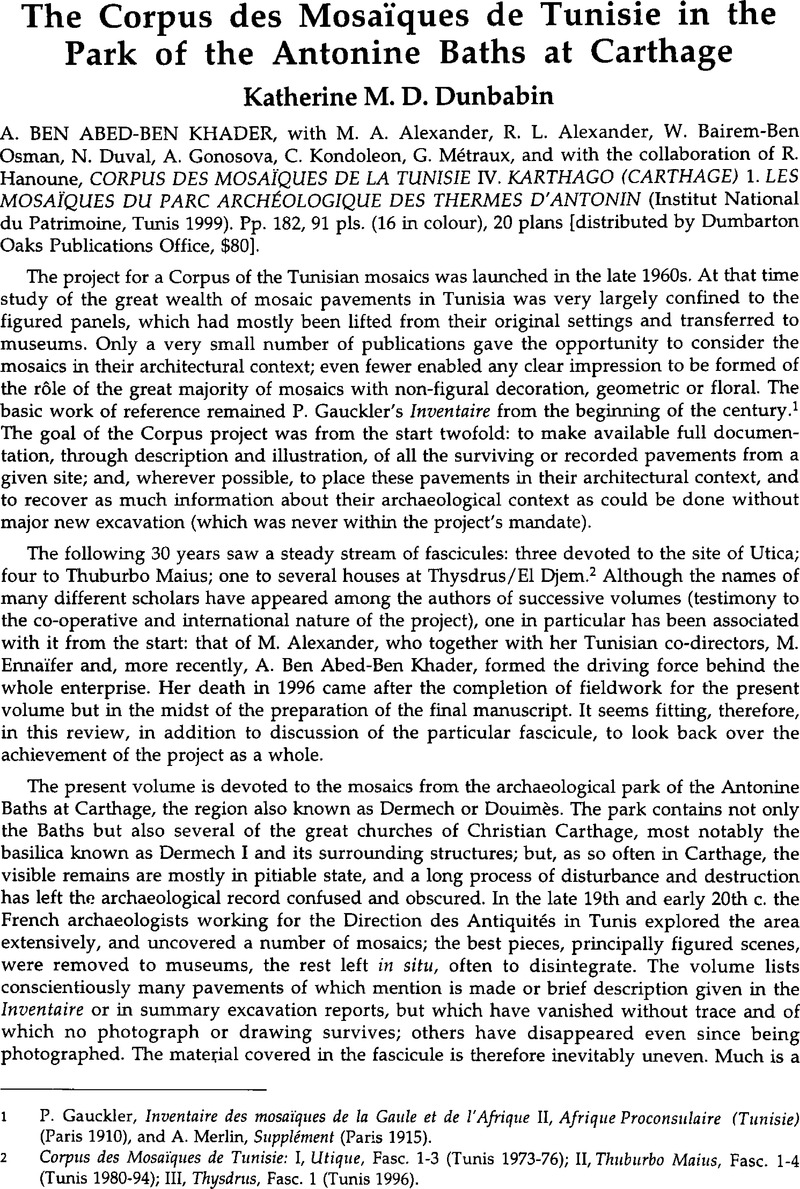No CrossRef data available.
Article contents
The Corpus des Mosaïques de Tunisie in the Park of the Antonine Baths at Carthage - A. Ben Abed-Ben Khader, with M. A. Alexander, R. L. Alexander, W. Bairem-Ben Osman, N. Duval, A. Gonosova, C. Kondoleon, G. Métraux, and with the collaboration of R. Hanoune, CORPUS DES MOSAÏQUES DE LA TUNISIE IV. KARTHAGO (CARTHAGE) 1. LES MOSAÏQUES DU PARC ARCHÉOLOGIQUE DES THERMES D'ANTONIN (Institut National du Patrimoine, Tunis 1999). Pp. 182, 91 pls. (16 in colour), 20 plans [distributed by Dumbarton Oaks Publications Office, $80].
Published online by Cambridge University Press: 16 February 2015
Abstract

- Type
- Reviews
- Information
- Copyright
- Copyright © Journal of Roman Archaeology L.L.C. 2002
References
1 Gauckler, P., Inventaire des mosaïques de la Gaule et de l'Afrique II, Afrique Proconsulaire (Tunisie) (Paris 1910)Google Scholar, and Merlin, A., Supplément (Paris 1915)Google Scholar.
2 Corpus des Mosaïques de Tunisie: I, Utique, Fasc. 1-3 (Tunis 1973–1976)Google Scholar; II, Thuburbo Maius, Fasc. 1-4 (Tunis 1980–1994)Google Scholar; III, Thysdrus, Fasc. 1 (Tunis 1996)Google Scholar.
3 Picard, G. Ch., “Une schola de collège à Carthage,” Karthago 3 (1952) 169–91Google Scholar.
4 Gauckler, P., Basiliques chrétiennes de la Tunisie (Paris 1913)Google Scholar.
5 It is regrettable that the two plans published here as Plans 16 and 17, and described as showing Phase 1 and Phase 2, differ in some respects from the account given in the text; they make no reference to the existence of Phases 3 and 4 distinguished in the text, and some details do not correspond. For instance, the text refers to the existence of 4 side aisles in the first phase, the outer two shorter at either end than the central nave and inner pair of aisles (103-4), while Plan 16 shows only the columns between the central nave and inner aisles, and omits any indication of the outer aisles. It is clear from the account on p. 104 that the plan is problematic here; but a note to explain the discrepancy would have been helpful. Similarly, it is not easy to follow the various changes in liturgical installations in the later phases (described on 115-16) when there is only a single plan given for all three later phases.
6 Ennabli, L., La basilique de Carthagenna et le locus des sept moines de Gafsa. Nouveaux édifices chrétiens de Carthage (Etudes d'Antiquités africaines 2000)Google Scholar, covering also the mosaics from the earlier, 5th-c. building beneath the basilica. The topographical reference of the name Carthagenna remains contro¬versial; see Duval, N., AnTard 5 (1997) 319 Google Scholar.
7 The preliminary account that I published in 1985 (“Mosaics of the Byzantine period in Carthage: problems and directions of research,” CÉA 17 =Carthage VII [Québec 1985] 9–29) now needs re-examinationGoogle Scholar.
8 One potentially misleading practice in the catalogue entries in this volume may be noted. It is not always apparent what basis, if any, exists for the dates proposed for the various mosaics, when these are not based upon new archaeological investigation. Several times the dates proposed for vanished mosaics, or for those whose original context is lost, are taken from earlier publications, including the notoriously simplistic dates proposed in the Inventaire (e.g. “époque des Antonins” for any mosaic considered at the time of good quality). While the practice of enclosing these in quotation marks should alert the reader to their potential unreliability, clearer warning of their danger would be desirable.




